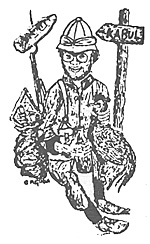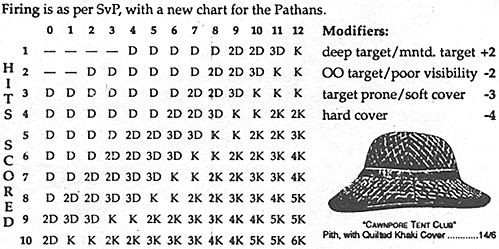 "When," said my friend, "are you going to do the NorthWest Frontier for 'Science vs Pluck'?" I can't remember whether the friend in question was Jim McDaniel by phone from California, or Peachey Carnehan in the Intermediate carriage outside Marwar junction. I promised that I would. Now, to do the thing properly would be a fair-sized undertaking, and since I have difficulty completing fair-sized undertakings within the decade I start them, I am instead presenting a working draft for the perusal, experimentation and general onceoverage of my wargaming friends. In general, all the usual stuff in SvP applies, with obvious modifications like substituting the word "Pathan" for "Dervish". I'd be interested to hear from anyone who has ideas, improvements, or any comments of a more-or-less noninsulting variety. So, for those of you who enjoy Kipling, or, indeed, those of you who have ever Kippled, here it is.
"When," said my friend, "are you going to do the NorthWest Frontier for 'Science vs Pluck'?" I can't remember whether the friend in question was Jim McDaniel by phone from California, or Peachey Carnehan in the Intermediate carriage outside Marwar junction. I promised that I would. Now, to do the thing properly would be a fair-sized undertaking, and since I have difficulty completing fair-sized undertakings within the decade I start them, I am instead presenting a working draft for the perusal, experimentation and general onceoverage of my wargaming friends. In general, all the usual stuff in SvP applies, with obvious modifications like substituting the word "Pathan" for "Dervish". I'd be interested to hear from anyone who has ideas, improvements, or any comments of a more-or-less noninsulting variety. So, for those of you who enjoy Kipling, or, indeed, those of you who have ever Kippled, here it is.
Officer's Pocketbook: Edited selections from Callwell's chapter on Hill Warfare, Robert's "Forty-One Years in India", Chamberlain's Field Force instructions for the 2nd Afgan War, Warburton's memoirs for the political officer's end of things. I haven't really looked into it, but I assume that there must be many sources of useful advice to young officers in the frontier literature - after all there were expeditions in the hills every few months for a hundred years. John Masters for the later years. Who else? Send me suggestions, or, better still, photocopies of useful passages, and I'll work on putting them together.
 Classification of Troops: on the Imperialist side, I think we ought to differentiate between units with extensive experience on the frontier, and those without. The key differences would be in terms of movement and the ability to spot enemy movements.
Classification of Troops: on the Imperialist side, I think we ought to differentiate between units with extensive experience on the frontier, and those without. The key differences would be in terms of movement and the ability to spot enemy movements.
On the other side, the difference is between tribal warriors from the hill clans, and the at-leastpartially drilled regulars of the Amirs of Kabul. Then, of course, we could include the Czar's Legions.
"Frontier troops" include such excellent fellows as the Gurkhas, Guides, Punjab Frontier Force, and lesser types like the Khyber Rifles. One might also include British and Indian "lowland" units with very long records of hill campaigning.
Movement Rates are the same as usual, with the addition of elephants which move at 40 yards per minute, whether in "pack" mode, carrying mountain A guns, or teamed in pairs for heavy wheeled ordnance. What is different are the rules for rough terrain. On the N.W.F. there is precious little open ground outside the major valleys. Broker country varies from minor obstructions - rocks, open pine woods, lesser slopes - to serious mountain barriers.
Let's divide it into:
- Open; flat valley floors, good roads and tracks.
Rough; fairly broken terrain, mountain paths through more difficult ground.
Rugged; steep slopes, nullahs, rocky hills.
Inaccessible; your basic crampon territory, passable only to open order foot at pathetically slow rates.
Impossible; 'nuff said.
| Troop Type | Rough | Rugged | Inaccessible |
|---|---|---|---|
| Pathans | 100% | 75% | 50% |
| Frontier infantry in column or Open Order | 100% | 75% | 25%D |
| Infantry in column or Open Order, pack mules | 75% | 50% | 10% 2D |
| Any troops in line or square, frontier cavalry, camels | 50% | 25% D | - |
| Cavalry, elephants, light artillery | 50% D | 25% 2D | - |
| Heavy guns, wheeled carts, wagons, etc. | 30% D | 10% 2D | - |
 Snipers were a notable feature of frontier warfare; while the scored few hits - one estimate is that only I shot in 7,000 told, at least against an enemy in camp - the shooting of single Pathan marksmen served to unnerve the camp followers, disorder the marching column, and, very occasionally, knock over one of the soldiers of the queen. I suggest that the best way of handling this would be to announce to the players that, every so often, they are under sniper fire, and roll a D6. on ;g "6", there has been a visible casualty, as opposed to a possible but unseen hit somewhere in the column or camp., Roll again; 1-3 is a nameless sepoy/grasscutter/pack mule; 4-5 hits a NPC, whom we will name with graphic detail, to worry the player. On a 6, one of our heroes is hit - roll on the Officer Casualty table.
Snipers were a notable feature of frontier warfare; while the scored few hits - one estimate is that only I shot in 7,000 told, at least against an enemy in camp - the shooting of single Pathan marksmen served to unnerve the camp followers, disorder the marching column, and, very occasionally, knock over one of the soldiers of the queen. I suggest that the best way of handling this would be to announce to the players that, every so often, they are under sniper fire, and roll a D6. on ;g "6", there has been a visible casualty, as opposed to a possible but unseen hit somewhere in the column or camp., Roll again; 1-3 is a nameless sepoy/grasscutter/pack mule; 4-5 hits a NPC, whom we will name with graphic detail, to worry the player. On a 6, one of our heroes is hit - roll on the Officer Casualty table.
Pathan weapons varied from warrior to warrior, being a mixture of traditional 'jezail" matchlocks, old British service firearms, and anything else that came to hand. By the 1897 rising, large numbers of Martini-Henrys were in tribal hands, and gunrunning across the sea from Arabia was becoming a serious issue to British authorities. Afghan regulars in the, 1878-81 war carried Sniders of Enfield muzzleloaders. We might say that Pathans are either "badly" or "well" armed, depending on the time and place, and that within a tribal "lashkar", some clans might be well-armed, others not.
| Armed | Point Blank | Close | Medium | Long | Snipers |
|---|---|---|---|---|---|
| "Badly Armed" | - | 100 | 250 | 500 | Snipers to 1,000 |
| "Well Armed" | 100 | 250 | 500 | 1,000 | Snipers to 1,500 |
Ghazis were the fanatics of the frontier. In most incidences, they comprised small bands, but at times of great enthusiasm, such as the rising fomented by the Mullah Powindah in 1897, or the Fakir of Ipi in the 1920's. The whole Pathan army besieging the Malakand forts appeared to be in a fanatical state for weeks on end.
Ghazis count "+3" for reaction purposes, which ought to ensure fairly berserk behaviour!
Percentage of Ghazis
Roll a D10:
1 no Ghazis
2-4 5%
5-7 10%
8 25%
9 50%
10 all of' 'em!
 Reaction tables are as for basic SvP, but with new modifiers to show the Pathan's fear of heavy casualties and of having their retreat cut off. To make up for this, there is the "+3" for Ghazis.
Reaction tables are as for basic SvP, but with new modifiers to show the Pathan's fear of heavy casualties and of having their retreat cut off. To make up for this, there is the "+3" for Ghazis.
Modifiers:
Malik or Mullah present/enemy routing/ Ghazis/friends clearly victorious +3
Enemy retreating/ friends advancing +2
Each 10% lost -1
Facing charge by formed infantry/under artillery fire -1
Facing cavalry charge/enemy to flank/Malik or Mullah hit -3
Enemy threatening rear -5
Camp followers were an integral part of Indian campaigning, and should serve to give the players a variety of problems. So - reaction ought to be -2, milling about when "excited", and getting in the way of soldiers when nervous or panicked.
Unarmed, will scatter if attacked, move slowly with the baggage, but c.100 yards per minute when upset in any way.
Do not allow players to rid themselves of the followers without major problems ensuing, especially to the morale of the Indian troops.
Other Stuff: there are a number of areas that ought to be addressed - care for the Imperial wounded so that they are not "left on Afghanistan's plains", rules for rolling rocks down hills, for later innovations like armoured cars, aircraft and light tanks.
Scenarios might include night marches, withdrawals under fire and "political" operations, as well as the well known "butcher and bolt" punitive expedition.
Back to MWAN # 38 Table of Contents
Back to MWAN List of Issues
Back to MagWeb Magazine List
© Copyright 1989 Hal Thinglum
This article appears in MagWeb.com (Magazine Web) on the Internet World Wide Web.
Other articles from military history and related magazines are available at http://www.magweb.com